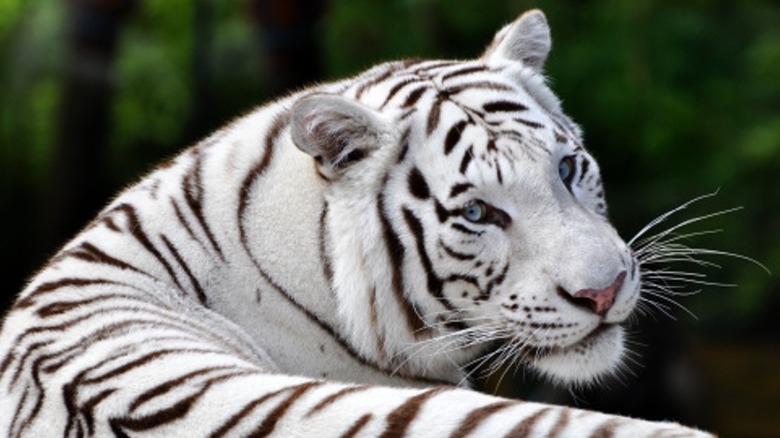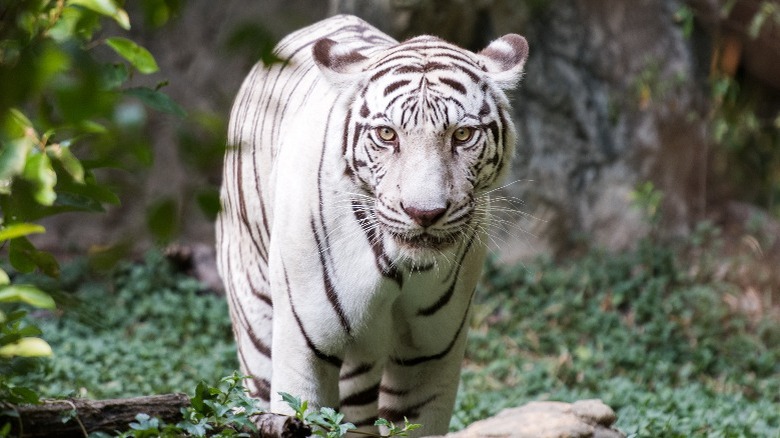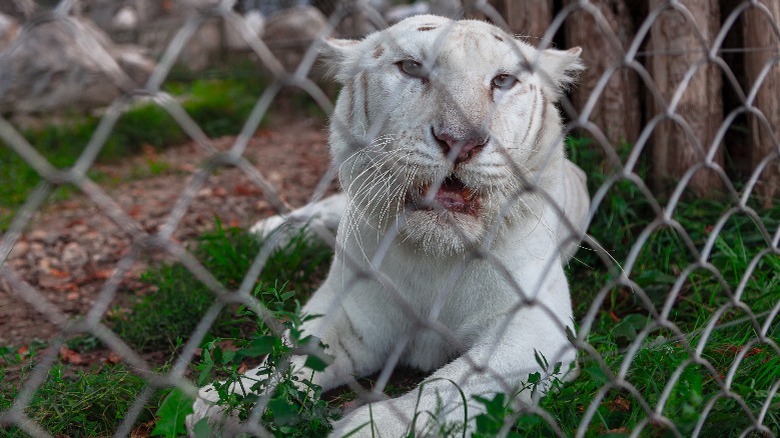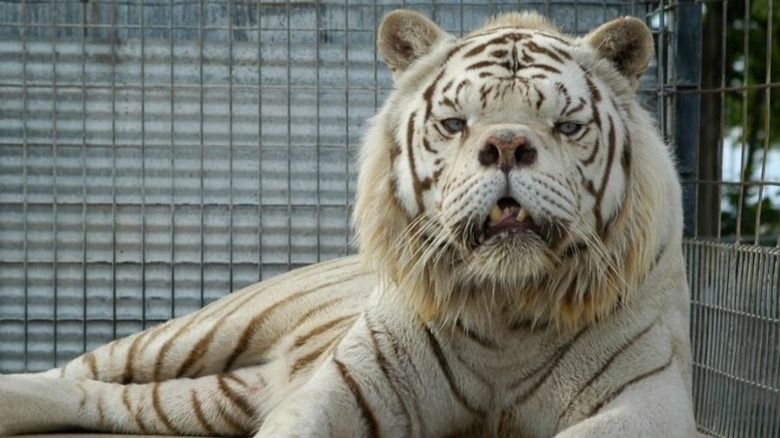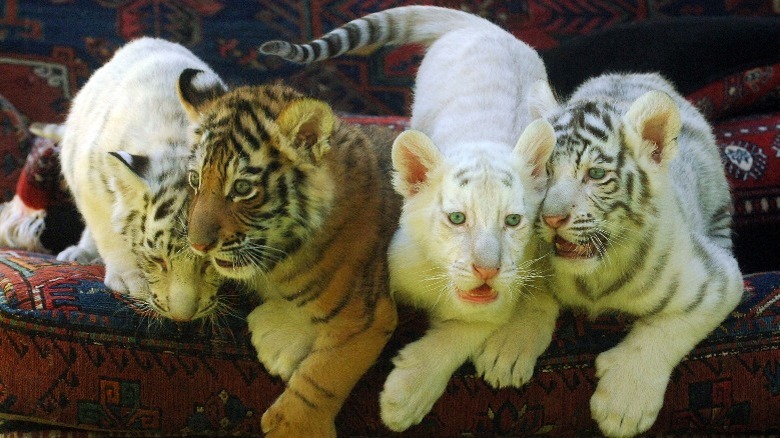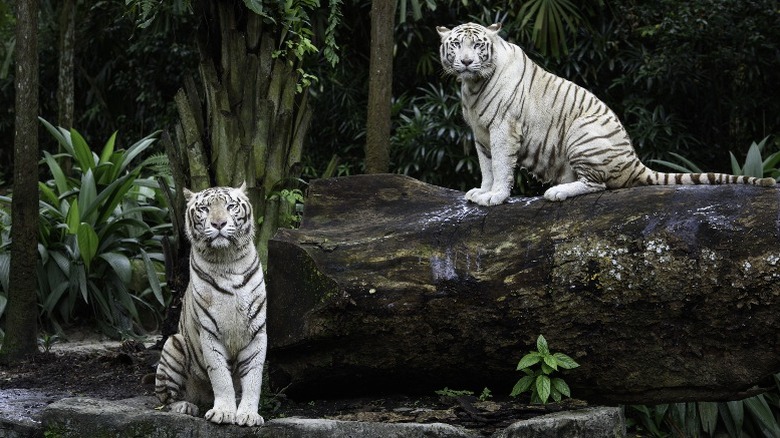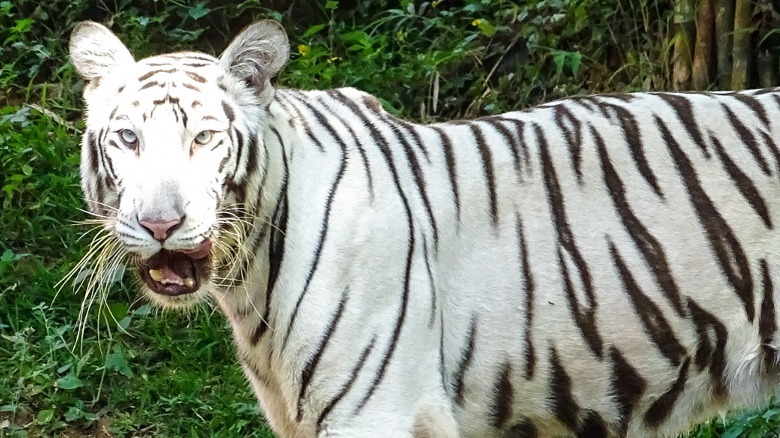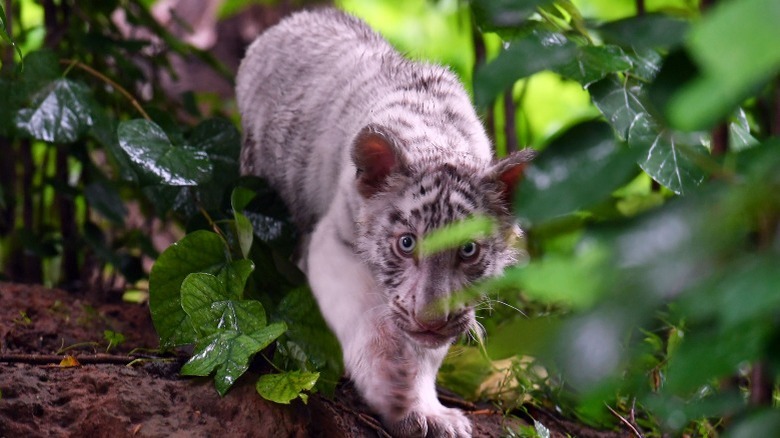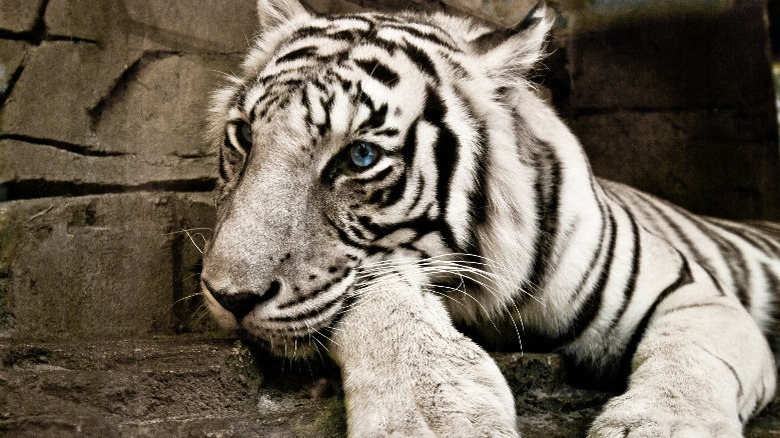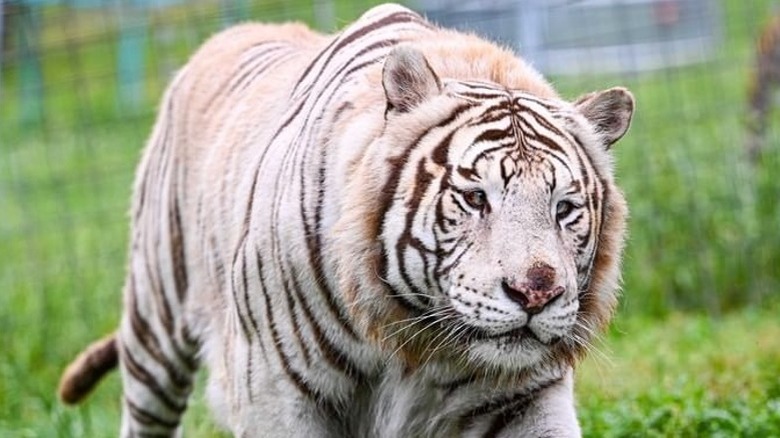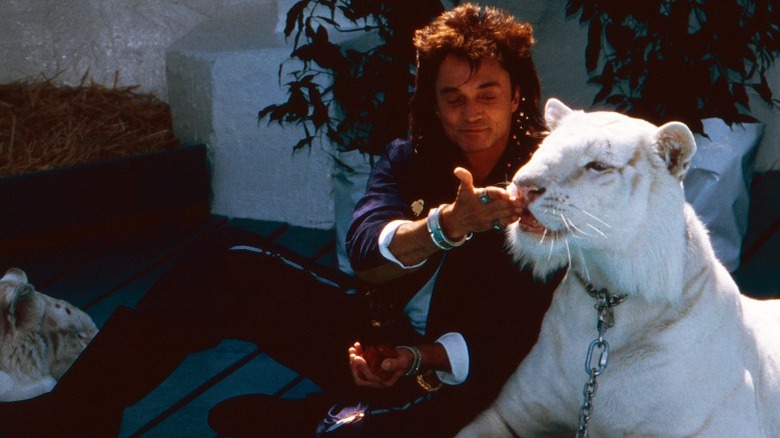The Dark And Tragic Reality Of White Tigers
Whether lounging at a zoo, posing alongside Megan Thee Stallion in a Cardi B music video, or gracing the cover of your favorite Lisa Frank trapper keeper from elementary school, white tigers are always sure to catch the eye. With their alluring blue eyes, bright pink noses, and striking black-and-white striped coats, these unique big cats present a perfect study of beauty and contrast long cherished by Hollywood filmmakers, magicians, and zoo patrons alike.
Contrary to popular belief, the white tiger is not a distinct species or even a subspecies, like the Bengal tiger or Siberian tiger. Rather, these cats' unique coloration is caused by a genetic mutation that occurs naturally – though extremely rarely – in Bengal tigers, making them more akin to calico cats or blue merle dogs. White coloration in typically orange and black tigers is a form of leucism – that is, an inherited partial reduction in pigmentation – which causes a body-wide lack of red, orange, and yellow coloration but leaves some hues, like black and blue, intact.
While leucism itself isn't necessarily a harmful condition, the process of breeding a continued supply of tigers exhibiting the rare mutation is unfortunately quite problematic. In the quest to keep producing prized – and therefore extremely profitable – white tigers, people have resorted to unethical breeding techniques, barbaric and cruel practices, and outright lying, none of which have been good for the cats. Here is the dark and tragic reality of white tigers.
Wild white tigers were disadvantaged
White tigers do occur naturally, though one hasn't been born in the wild in over 65 years. They are extremely rare – and for good reason, evolutionarily speaking. Tigers are nocturnal ambush predators that rely on stealth and camouflage to stay hidden as they plan their perfect attack. The ability to hunt is necessary for survival, and young tigers spend months learning how to stalk and kill effectively from their mothers before they go out on their own.
In fact, hunting is so challenging that about 50% of all wild tiger cubs don't survive their first two years, meaning it's plenty hard enough without being born with a serious handicap. Unlike their orange counterparts, white tigers stand out against their forest and grassland environments. This means that they are at a severe disadvantage when it comes to stalking their preferred prey – large mammals like deer and wild boars – which, according to a 2019 study published in the Journal of the Royal Society Interface, cannot see orange fur against a green background but can easily see white.
This inability to camouflage also exposes white tigers to potential attack. Though they are top predators, young or weakened tigers can fall prey to crocodiles, snakes, leopards, other tigers, and possibly even pack-hunting wild dogs called dholes. In addition, white tigers are also genetically more likely to suffer vision problems. With the process of natural selection working against them, it's likely that, historically, most wild white tigers starved to death.
The last wild white tigers were killed by trophy hunters
Though exceedingly rare, white Bengal tigers did sometimes succeed in the wild. Unfortunately, their rarity only made them more alluring to hunters seeking an unusual trophy. According to the Science Reporter, writer Abul Fazal recorded the first white tigers in India in 1561. In the second volume of "The Akbarnama" – a series of books documenting the reign of Emperor Akbar – Fazal described his entourage hunting and killing a tigress and her five older cubs in the jungle near the historic town of Narwar with swords and arrows. In one of the book's accompanying paintings, two of the cubs were depicted with bright white coats.
By the late 1800s, historical white tiger encounters almost always ended in shootings, and, over the years, hunting of the rare animals only increased. As the Journal of the Bombay Natural History Society of India noted (via the Science Reporter), a shocking 17 white tigers were shot in India between the years of 1907 and 1933. White tigers were most common in the forests near Rewa, a city in the Indian state of Madhya Pradesh. Occasionally, hunters would bring the unique white cats in alive to display, as was the case with a white tiger captured in 1915 and a cub named Mohan who was kept alive after his family was killed. Sadly, wild white tigers haven't been seen in India since the last one was shot by a trophy hunter in 1958.
All captive white tigers are inbred
In the wild, only about one in 10,000 tigers has white fur. In addition to being extremely rare on its own, the genetic mutation that causes white coloration is recessive, meaning a tiger must inherit a copy from both parents in order to be born white. Simply put, there aren't a lot of white tigers out there. Or, rather, there wouldn't be without human intervention.
The most effective way to create more white tigers is to breed two together. But how do you find two when one is rare? Well, it's not pretty. Most of the estimated 200 white tigers in captivity today are descended from a single wild-born male Bengal tiger named Mohan, who was captured in India in 1951. Rather than wait around to get lucky, Mohan's keepers repeatedly bred him to his white daughter and granddaughters to produce a small collection of white tigers. Eventually, these tigers and their relatives ended up all over the world.
Shockingly, only one other lineage of white tigers exists. According to veterinarian Daniel Laughlin in an article he wrote for Big Cat Rescue, a United States zoo first crossed a Bengal tiger to a Siberian tiger, then bred their offspring to one another, which resulted in a few white cubs. One of these tigers was then bred to a white tiger from Mohan's lineage, spawning all white tigers currently in the U.S. Given this extremely small gene pool, every modern white tiger is seriously inbred.
White tigers suffer from many serious health issues
While having a white coat may decrease a tiger's ability to survive in the wild, it doesn't necessarily cause health problems on its own. Inbreeding, however, does. Because the genes responsible for white coloration are recessive, the most reliable way of producing a white tiger is to mate one to another. But, with white tigers in short supply, the only way to do this is through inbreeding – that is, breeding two closely related tigers together.
In addition to selecting for one recessive trait – like white coloration – inbreeding also inadvertently selects for a slew of other recessive qualities, many of which are harmful. After all, there's a reason nature typically favors things like dispersal, outbreeding, and genetic variation! Repeated inbreeding further concentrates these detrimental traits, resulting in a general decrease in fitness, health, and fertility known as inbreeding depression.
Along with the desired white coat come many health issues, including facial deformities, spinal abnormalities like scoliosis, faulty organs, cleft palates, hip dysplasia, club feet, bulging eyes, short legs, an inability to swallow and digest food, neurological disorders, small litters, infertility, weakened immunity, and heart problems, just to name a few. Many of these ill effects could be seen in Kenny (pictured), a rescued white tiger who went viral due to his unusual bulldog-like appearance. For these reasons, the Association of Zoos & Aquariums banned the reckless breeding of white tigers – and all leucistic animals – in 2011.
Many tigers must die to produce a single white tiger
Because the genes for an orange coat are dominant, the vast majority of tigers are born orange, even when one or both parents are white. As a result, tiger breeders end up with a surplus of orange cubs in their never-ending quest for more white tigers. What's worse, many white cubs are born dead, unhealthy, or seriously disfigured due to inbreeding, making them unfit for public consumption. This leaves an uncomfortable question: What happens to all these rejected tigers?
With few reputable zoos interested in genetically unsound tigers, many end up being sold to far more nefarious outlets, like roadside zoos, private collections, and pseudo-sanctuaries. As anyone who has watched Netflix's 2020 docuseries "Tiger King" knows, this is far from a happy fate. Others are sold into the lucrative – but disreputable – "cub-petting" trade, in which paying customers can cuddle, hold, and take selfies with baby tigers. But, of course, these cubs eventually grow up.
In the end, most unwanted tigers meet an early death. Though they can live up to 20 years, few of the estimated tens of thousands of tigers in captivity ever reach that age. Feeding an adult tiger is expensive, and, once they become unprofitable, they are cruelly dispatched, used in canned hunts, or sold on the black market for their valuable organs. Overall, some 30 to 60 tigers die in the process of breeding a single desirable white tiger.
They hinder wild tiger conservation efforts
One hundred years ago, there were around 100,000 wild tigers roaming the forests and grasslands of Asia and Eastern Europe. But, as of 2023, habitat loss and poaching have reduced their numbers to around just 4,500, rendering all six living subspecies seriously endangered. Today, there are way more tigers in captivity than there are in the wild. This could be a good thing, considering that these captive tigers could potentially help boost the genetic variation of dwindling wild populations.
But there's a problem: Rampant irresponsible breeding to produce white tigers has majorly sullied the gene pool. For one, even if they appear in good health, all white tigers – as well as the many standard orange tigers produced in the process of breeding white tigers – are significantly inbred. Many are also hybrids of the two most commonly kept tiger subspecies, the Bengal tiger of India, Bangladesh, and Nepal, and the Siberian tiger of China and Russia, making them useless for captive breeding programs and reintroduction into either population.
And, perhaps worst of all, the sheer volume of unwanted captive tigers produced in the name of securing a single ideal white tiger specimen inundates zoos and rescue centers, taking vital money, space, and resources away from wild tiger conservation efforts. As Jackson Landers wrote in Slate: "Every zoo that devotes an enclosure to white tigers under the cover of a lie about conservation represents one more place where a legitimately endangered tiger could be kept."
White tigers are more sensitive to sunlight and anesthesia
In addition to suffering from a plethora of inbreeding-related health issues, many white tigers also develop conditions directly related to their unique coloration. Like albino animals, white tigers are more sensitive to sunlight. Their reduced pigmentation makes them more prone to sunburns, and many also develop skin cancer. As the Mayo Clinic notes, human skin cancer is often associated with having less melanin in the skin, hence why it is more prevalent in fair-skinned individuals.
The same seems to be true in tigers. A 2023 study published in the Journal of Zoo and Wildlife Medicine found that, out of the study's seven tigers diagnosed with skin cancer, five were white. Indeed, skin cancer has claimed the lives of many white tigers over the years, including both Natasha and Kanpur at Florida's Metrozoo, Omar at the Singapore Zoo, Hannah at the Alexandria Zoo, and Kenny at the Turpentine Creek Wildlife Refuge.
Strangely, white tigers also seem to be more sensitive to anesthesia. As veterinarian David Taylor notes in his book "Vet on the Wild Side," albino animals often react differently to anesthetics due to an inability to produce an enzyme. After sedating a white tiger named Savari for a routine procedure in 1987, he found that leucistic cats might be similarly affected. Savari stopped breathing and had to be revived with oxygen. It took him two days to fully recover. Then, in 1992, a white tiger named Cheytan died following anesthesia complications.
They are victims of human greed
Ever since the first white tigers were displayed in 1950s India, people saw the potential to make money off the rare cats. According to the Science Reporter, Mohan – a white tiger captured as a cub in India in 1951 – fathered a total of 34 cubs, 21 of which were born white. They ended up in zoos all over the world, and many quickly capitalized by producing more of the alluring animals.
The United States' Cincinnati Zoo became a top breeder of white tigers. They acquired their first white cats from Washington, D.C.'s National Zoo, which had received at least one of their tigers from India. Former Cincinnati Zoo director, Ed Maruska, admitted that the unique cats were major moneymakers. "They turned the turnstiles in our zoo," Maruska explained to the Zoo & Aquarium Video Archive in 2021. "I was able to sell a number of white tigers, and those monies – which were a considerable amount of money – went into a fund."
The Cincinnati Zoo's white tigers ended up in many private collections, including Siegfried & Roy's. The Association of Zoos & Aquariums banned the breeding of leucistic cats in 2011 due to inbreeding and health concerns, but this only drove the practice into the unregulated underground, where breeding white tigers remains a highly lucrative business. In fact, it's estimated that a standard white tiger sells for around $30,000 to $60,000, while even rarer pure white tigers can be worth up to $100,000.
Many organizations perpetuate lies about white tigers
One of the most enduring myths about white tigers is that they are an endangered species in need of conservation. This is – pun intended – a white lie. White tigers are merely a color morph of the Bengal tiger, a real endangered subspecies in need of conservation best achieved through habitat preservation and breeding programs that promote genetic diversity. Produced through repeated inbreeding, modern white tigers neither aid conservation efforts nor require saving. And you'll be hard-pressed to find anyone trying to reintroduce one of their valuable cats to the wild.
Unfortunately, many establishments continue to claim that it is necessary to breed the animals to save them from extinction, sometimes referring to them as an endangered species called the "royal white tiger" – a bogus term popularized by the entertainment duo Siegfried & Roy. It's a fable that has been so long perpetuated that a 2012 Facebook survey conducted by Slate revealed that 96% of those surveyed believed it, with several citing the oft-repeated story that they are a tiger subspecies adapted to living in the snow.
This misinformation campaign largely exists so many – like the Cincinnati Zoo and the "cub-petting" trade – can continue making money off the rare cats. Ask any biologist or geneticist, though, and they'll advocate for letting white tigers "go extinct." As conservationist and tiger expert Dr. Ron Tilson (via Big Cat Rescue) stated: "The white tiger controversy among zoos is a small part ethics and a large part economics."
All white tigers have faulty vision
As if having tons of health problems and being more sensitive to sunlight wasn't bad enough, all white tigers have some pretty serious vision issues that are, surprisingly, unrelated to inbreeding. A 1973 study published in Science found that a white Bengal tiger cub had abnormal vision pathways in its brain, while its sibling, a standard orange-colored tiger, lacked this defect. According to the researchers, this indicated that the genes responsible for pigment reduction – as seen in leucistic and albino animals – were likely linked to the genes for visual pathways.
So, basically, when selecting for white coats, tiger breeders are also inadvertently selecting for faulty vision. Indeed, a 2014 study published in Clinical Genetics observed that white tigers, in addition to other genetically pale animals like albino primates and Siamese cats, were more likely to suffer visual afflictions like strabismus. As WebMD notes, strabismus is the fancy name given to the eye alignment condition called "crossed-eyes" or "walleye." It is often genetic and can become more pronounced when a person – or tiger – is stressed.
All of this means that many white tigers are visibly cross-eyed, and all suffer visual impairments because their optic nerves are essentially wired wrong, impacting how information is sorted in their brains. This makes them clumsy and, oddly enough, desirable as performing animals as they have diminished reaction times and therefore are forced to rely on their trainers more. Of course, this didn't work out well for Siegfried & Roy.
They have famously attacked their handlers
Due to their attention-grabbing appearance and vision-related reliance on their handlers, white tigers are popular in stage shows. But, no matter how tame they seem, they are still tigers – a.k.a. fierce top predators who were born to hunt and kill. One performing troupe, Ron and Joy Holiday's Cat Dancers, learned this the hard way in 1998. On October 8, a white Bengal stage tiger named Jupiter fatally bit trainer Chuck Lizza on the neck after he tripped while rushing to help fellow performer Joy Holiday calm the spooked tiger. Just five weeks later, Jupiter – whose life was spared by the surviving performers – attacked and killed Joy Holiday by biting her neck during a feeding, prompting police to kill the tiger. The tragic events inspired the 2007 HBO documentary "Cat Dancers."
And then came Siegfried & Roy, the German-American duo whose magical shows became practically synonymous with white tigers – for reasons both good and bad. One of the most popular entertainment acts in Las Vegas, the duo consisting of Siegfried Fischbacher, Roy Horn (pictured), and their iconic white tigers once adorned giant billboards throughout Sin City and performed regularly at The Mirage casino. That is, until October 3, 2003, when a white tiger named Mantacore famously mauled trainer Roy Horn mid-performance in front of a giant live audience. Horn, who barely survived the attack, suffered life-altering injuries. As a result, the duo's act was promptly retired – though Mantacore was allowed to keep his life.
White tigers are also valuable after death
Sadly, a white tiger's story doesn't always end at death. Aging exhibit tigers, deformed white tigers, and the hundreds of surplus orange tigers alike still carry value on the black market, especially in China, where tiger parts have endless uses in traditional medicine. Their bones are a key ingredient of tiger bone wine, a highly-coveted alcoholic elixir said to treat a variety of ailments – though it's now mostly used to signal wealth and status. With an 8-year-old bottle selling for around $290, it's a big hit at parties.
Tiger teeth, skulls, whiskers, claws, eyes, paws, and even genitals are also prized for medicinal uses. Meanwhile, pelts – particularly those of rare color morphs – are valued as décor. Skins sell for around $20,000, while full rugs can cost up to $124,000. And an entire stuffed tiger? That can go for around $700,000. According to a 2022 study published in Conservation Science and Practice, bones and skins are the most popular tiger parts, indicating that uses related to luxury are increasing.
Although the sale of tiger parts is illegal under the Convention on International Trade in Endangered Species (CITES), the payout is substantial enough to keep it going. And while there aren't many tigers left in the wild, there are certainly plenty of unwanted captive tigers to offload, due in large part to the continued demand for those with black and white stripes. There's big money in white tigers, whether they are dead or alive.
